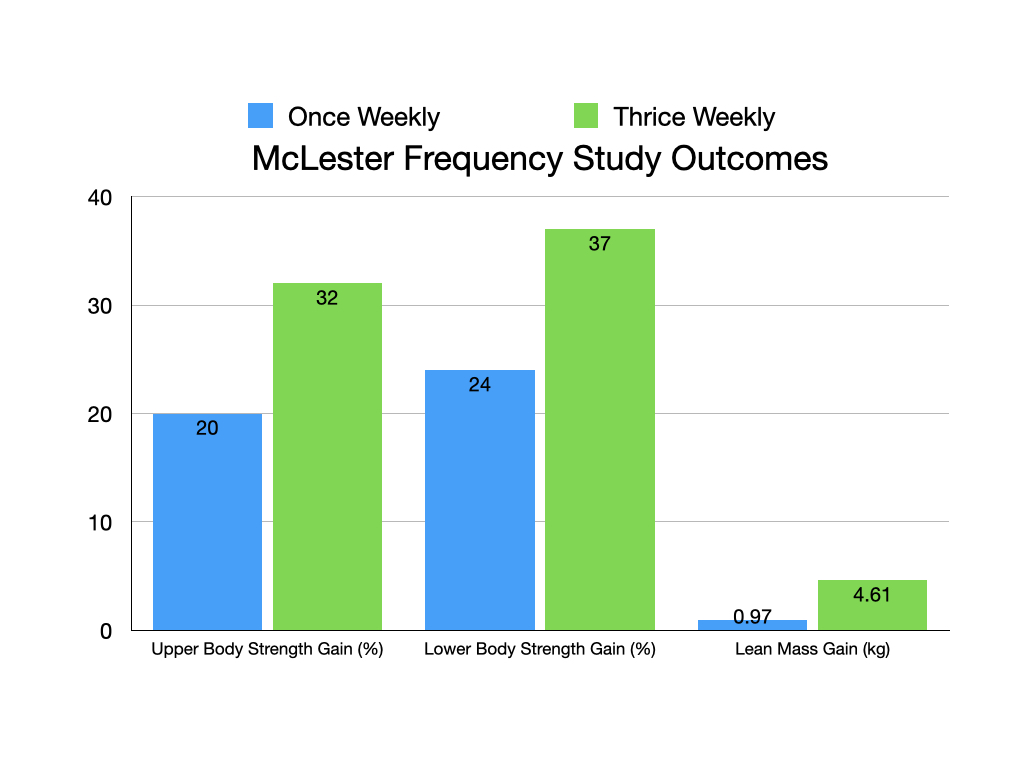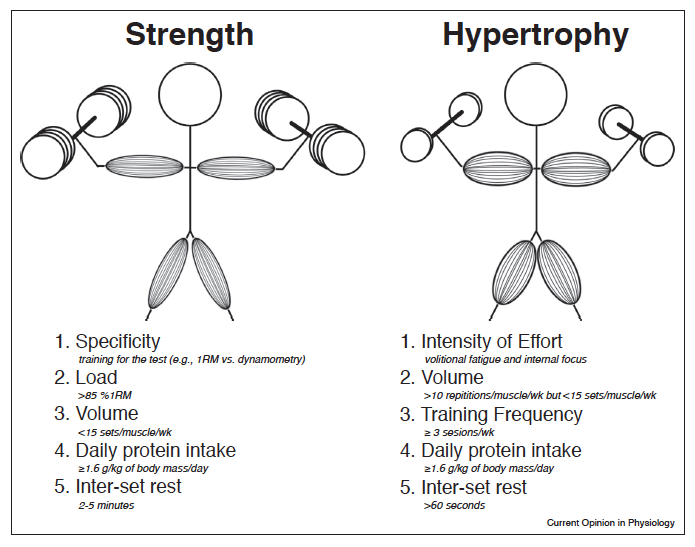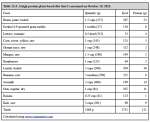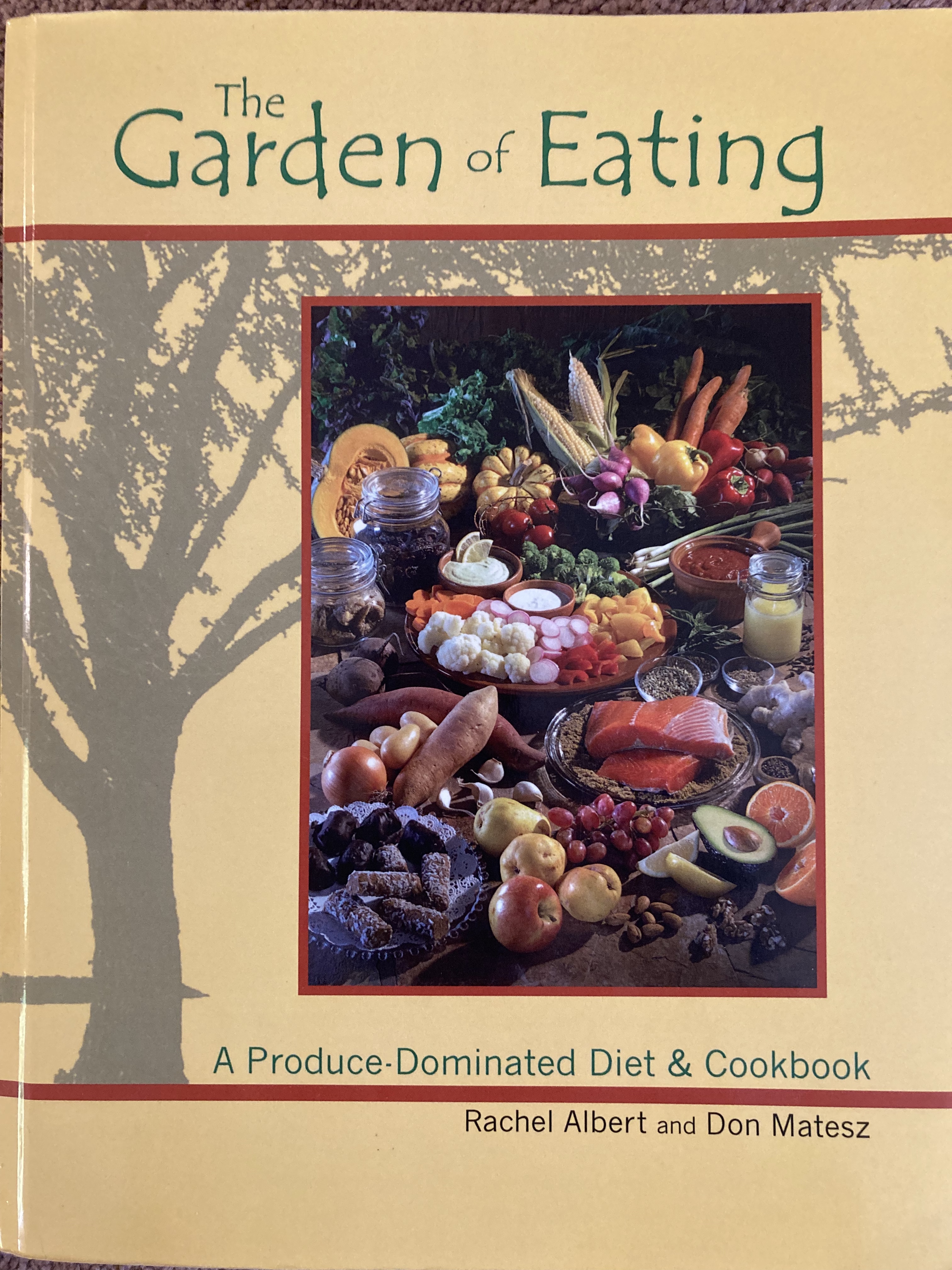Training for Strength and Hypertrophy
An Evidence-Based Approach
“Training for strength and hypertrophy: an evidence-based approach” was written by Robert W Morton, Lauren Colenso-Semple, and Stuart M Phillips, and published in Current Opinion in Physiology 2019;10:90-95.
This article reviewed the scientific literature on training for strength and hypertrophy to summarize evidence-based recommendations for resistance training (RET) to develop muscular strength and size.
Training for Strength
As expected by anyone understanding the S.A.I.D. (specific adaptations to imposed demands) principle, training for strength and hypertrophy can be divided into training for strength and training for hypertrophy. The methods sufficient for maximal strength training are not necessarily optimal for hypertrophy training.
Regarding training for strength, Morton et al assert that research has identifed five factors critical to optimal training for strength performance:
- Specificity
- Load
- Volume
- Daily protein intake
- Inter-set rest
Regarding specificity, if you want your training to maximize your strength for a specific test, you should train specifically for that test. In other words, you should train the specific task you want to use to demonstrate strength. For example, if you want to maximize your bench press, you should practice the bench press.
Regarding load, if practicing a specific task, such as the maximal bench press, you will increase strength most if you use training loads near to maximal, such as greater than 85% 1RM, which means loads that permit no more than 5 repetitions at voluntary movement velocity.
Regarding volume, Morton et al note that “increased volume (or volume load [load x repetitions x sets]) does not, beyond a certain point, necessarily augment RET-induced changes in muscular strength….In fact, it seems that performing excessive weekly training volume results in a plateau or inferior changes in RET-induced strength (>15 sets per muscle group per week), which is likely due to insufficient recovery.” They cite a definitive study by Mattocks et al in which one group only performed five 1RM tests (i.e. only 5 repetitions) per session, while the other performed four sets of 8-12 repetitions per session.1 Both groups trained twice weekly. Despite a 10-fold difference in volume and volume-load between the two groups, there was no significant difference in strength gains between the two groups. Thus, one can obtain strength gains performing as little as 10 repetitions weekly.
Regarding frequency, Morton et al report that research indicates that higher training frequencies do not independently improve strength gains, regardless of whether volume is matched or unmatched. You can obtain strength gains training as little as once weekly; but this frequency may not support maximal hypertrophy (more about this below).
Regarding daily protein intake, Morton et al report that “increased protein intake up to at least 1.6 g/kg of body mass/day may provide a small but statistically significant benefit” for gaining strength. Legumes are the best protein sources.
Regarding inter-set rest (i.e. rest between sets), Morton et al state that recent evidence suggests that increasing inter-set rest (to greater than 2 minutes) may improve strength gains.
Training for Hypertrophy
Regarding training for hypertrophy, Morton et al identify five factors critical for optimal training programs:
- Intensity of effort
- Volume
- Training frequency
- Daily protein intake
- Inter-set rest
What about load? Morton et al note that a 2017 meta-analysis2 and numerous reports publish since that have shown that muscular hypertrophy is similar with loads ranging from ~30-70% 1RM provided that loads are lifted to the point of volitional fatigue, proving that load is not a critical factor in hypertrophy. In addition, Counts et al reported equal hypertrophy outcomes between performing biceps curls with intense contraction but no load, versus 70% 1RM, convincingly demonstrating that neither loading method, nor volume load contribute any specific effect on hypertrophy.3 However, it is important to note that in the Counts et al study the no-external-load training produced less than half the strength gains of the training with an external load. A study by Schoenfeld et al demonstrated that training intensity and hypertrophy outcomes are enhanced by an internal focus on maximally contracting a muscle group throughout the exercise’s range of motion.4
Hence, the critical factor is the intensity of effort, with superior outcomes provided by carrying sets to a point of volitional fatigue.
Regarding volume, Morton et al state:
|
“Some have proposed that there is a dose-response relationship between volume (repetitions x sets) and RET-induced muscular hypertrophy. In contrast, recent data have revealed that increasing volume or volume-load by manipulating the number of sets per session, number of repetitions per set, number of sessions per week, or load lifted per repetitions does not result in superior RET-induced muscular hypertrophy. However, supplementing a group of participants that were not performing RET to volitional fatigue with additional volume can match the RET-induced muscle hypertrophy of a group of participants that were performing RET to volitional fatigue. Thus, though second to performing RET to volitional fatigue, volume may have a small effect on RET-induced muscular hypertrophy in untrained populations. Otherwise, studies in resistance-trained individuals have found superior increases in muscle size with increased training volumes but only up to ~15 sets per muscle group per week. Moreover, even in untrained populations, optimal RET-induced muscular hypertrophy is contingent on performing a sufficient number of contractions (>10 repetitions per muscle per week). In conclusion, volume appears to be an ostensible mediator of RET-induced muscular hypertrophy in resistance-trained individuals, and it is clear that individuals should perform well over 10 repetitions/muscle/week but less than 15 sets/muscle/week to amass a weekly training volume that is necessary for RET-induced muscular hypertrophy.” |
Translation:
- In any case, to achieve any hypertrophy at all, a certain minimum volume must be performed, namely more than 10 repetitions per muscle per week.
- If you are training to volitional fatigue, then increasing volume by any means does not have any impact on outcomes of resistance training.
- If you are not training to volitional fatigue, then increasing volume (e.g. performing more sets) can match the outcomes of training to volitional fatigue.
- In resistance-trained individuals, increased training volume may produce greater hypertrophy per unit time, but only up to ~15 sets per muscle group per week.
Regarding frequency, Morton et al state that “there appears to be a modest benefit of performing RET thee times per week versus one time per week” if the higher frequency results in higher total volume; otherwise, under volume-matched conditions, “there is no measurable benefit of increased training frequency on RET-induced muscular hypertrophy.”
Here it is important to realize that training frequency influences training volume. For example, let’s compare training squats once weekly for 3 sets, versus thrice weekly for only 1 set each session. If you perform all three sets to volitional fatigue in one session once weekly, you will perform 1 set in a fresh condition, followed by 2 sets in a progressively fatigued condition. Hence your three sets might look like this:
200 x 15 = 3000
200 x 11 = 2200
200 x 8 = 1600
This will give you a total of 6800 pounds volume load for the week.
In contrast, if you perform 1 set thrice weekly, you perform all 3 sets in a fresh condition. Let’s just assume that you do 200 x 15 for all 3 sets spread over 3 training days. Now your volume load is 200 x 15 x 3 = 9,000 pounds volume load, which is 32% greater volume than you can achieve in a single session consisting of 3 sets.
Although these conditions have the same number of sets per week, reducing the session volume to a minimum while increasing frequency enables you perform a significantly greater volume of work by interposing ~48 hours of rest between every set performed.
At least one study – by McLester and colleagues – has shown that 1 set thrice weekly is from a practical standpoint markedly superior to 3 sets once weekly for hypertrophy. McLester et al compared the effects of doing a single set of 9 different exercises thrice weekly to those of doing 3 sets of the same exercises once weekly, with both groups training to volitional failure.5 Thus, prescribed set volume was matched but frequency and actual performance volume were not. Greater increases in both strength and muscle mass occurred in the group that did one set thrice weekly.

The group training with 1 set per exercise thrice weekly obtained about 50% greater strength gains and nearly 5 times greater lean mass gains (1 kg vs. 4.6 kg) than obtained by the group that trained with 3 sets once weekly. Put otherwise, those training with 3 sets per exercise performed only once weekly obtained only about 62% of the strength gains and less than one-quarter of the increase in lean mass!
Also, the once weekly group reported greater muscle soreness which the authors suggested may have been the result of greater detraining between sessions. Since the once weekly group had more soreness and less hypertrophy, this suggests that the once weekly subjects did not fully adapt to the exercise, with the result that more of their increase in post training muscle protein synthesis was directed to repairing the weekly muscle damage rather than growing new muscle tissue.
This study found that when weekly set volume is held constant (3 sets), spreading that volume out over 3 sessions may produce a more strength and hypertrophy than doing it all in one session. This in turn is likely due to the fact that greater work volume is performed when one does only 1 or 2 sets per session versus 3 or more, as explained above. Advocates of high intensity single-set training who claim that training once weekly will produce all the possible outcomes of resistance training should take note of this study. Some people will need 2-3 sessions per week with minimal volume (1-2 sets per muscle group) each session to obtain maximal hypertrophy results.
Another study compared the outcomes of doing one set of leg presses once weekly to doing one set twice weekly. Note that twice weekly represents a doubling of the dose of once weekly. Although the authors found no statistically significant difference between the two groups in strength development, they noted that “from a practical standpoint, the percentage of strength gained by the twice per week group (60%) was higher than that gained by the once per week group (38%). Therefore, individuals with performance related goals, such as athletes, might consider performing the leg press exercise two or more times per week.”6 It is worthy of note that this study found that once weekly training produced about 63% of the strength gains of the twice weekly training, similar to the study cited in the previous paragraph.
A study seeking to identify the dose of resistance exercise required to maintain previously gained muscle strength and size found that either 3 or 9 sets once weekly could maintain strength over 32 weeks for either young or old people, but 3 sets once weekly was insufficient for maintaining hypertrophy regardless of age, and 9 sets once weekly was sufficient to maintain mass gains in younger subjects but not older.7 This study confirms that frequency and volume are important factors for muscle hypertrophy but not for strength, particularly in older trainees.
A comprehensive review found no significant difference in hypertrophy outcomes between training two and three times weekly.9 Since training thrice weekly will not produce better results than twice weekly, there is no reason to train more than twice weekly. If training very hard you can maintain mass training once weekly, and many can gain mass training between once and twice weekly, such as training once every 4-5 days (e.g. full body sessions Monday-Friday-Wednesday-Monday-Friday-Wednesday, etc.) amounting to twice in 10 days.
Regarding protein intake, Morton et al refer to a previous systematic review of the effect of protein supplementation on hypertrophy and found that an intake of 1.6 g/kg maximizes gains of muscle mass from resistance training.8
Regarding inter-set rest, Morton et al refer to a systematic review including six studies that hypertrophy outcomes may be improved by increasing inter-set rest intervals to more than 60 seconds duration. Probably increasing rest intervals reduces the negative effect of fatigue on performance, resulting in an increase in volume load in each set performed.
Regarding other variables, Morton et al found that research so far suggests the following factors have little or no effect on hypertrophy outcomes: time of day for training, velocity of contraction, single-joint vs multi-joint exercise, days of recovery between training sessions, blood flow occlusion, and autonomy over resistance training variables.
Morton et al provided the graphic below to summarize evidence-based guidelines for training for strength and hypertrophy:

Training for Women
The evidence reviewed by Morton et al. indicates that women respond to the same resistance training factors as men.
|
“In women, there is little-to-no influence of load, volume, velocity of contraction, or inter-set rest duration on RET-induced changes in muscle strength and/or mass, and the efficacy of protein supplementation to support these gain while small is apparently no different in women…women have a similar propensity for RET-induced changes in muscle mass and strength and are not differentially affected by specific RET-related variables.” |
In other words, any one who says women should train significantly differently from men is not offering an evidence-based program.
Training for Strength and Hypertrophy Together
Training for strength and hypertrophy are not mutually exclusive. From the above, we can see that if we want to train for both strength and hypertrophy these are the critical factors to include in our programs:
- Specificity: Perform basic exercises which will improve general strength in the major muscle groups, or the exact task(s) to be tested.
- Intensity: Train to volitional failure (unwilling to continue the task) with internal focus.
- Load: Use an external load that is between 65-80% 1RM (8-20 RM) for each exercise
- Volume: At least 10 repetitions and no more than 15 sets per muscle per week. In practice, with proper exercise performance, you only need 1-2 sets per muscle group per session.
- Frequency: One or two hard sessions per week on average.
- Interset rest: 2-3 minutes when doing consecutive sets of the same or similar task; otherwise rest long enough to prevent oxygen debt from impairing exercise performance.
- Daily protein intake: At least 1.6 g per kg body weight.
Training for Strength and Hypertrophy Summary
Effective, evidence-based resistance training for strength and hypertrophy is a simple affair. The primary driver of your results is your level of effort.
To optimize strength gains for specific tasks, perform the specific test(s) (e.g. the bench press, deadlift and squat for powerlifters) at least once weekly with loads near maximal (>85% 1RM), and eat adequate protein.
To optimize muscle hypertrophy, prioritize training with an internal focus and a high intensity of effort (i.e. to volitional fatigue), using safe exercises for a sufficient number of repetitions (more than 1-4 sets per week), a training frequency of thrice weekly, an inter-set rest of at least 60 seconds, and consume no less than 1.6 g of protein per kg of body weight per day.
For many people, coaching provides the the critical factor to keep them motivated, dedicated and following a program and protocols properly. If you need help developing a program and staying on track when training for strength and hypertrophy, consider hiring a coach, such as myself, who understands how to design and supervise evidence-based training for strength and hypertrophy.
Notes
1. Mattocks KT, Buckner SL, Jessee MB et al.: Practicing the test produces strength equivalent to higher volume training. Med Sci Sports Exerc 2017, 49:1945-1954. <https://journals.lww.com/acsm-msse/Fulltext/2017/09000/Practicing_the_Test_Produces_Strength_Equivalent.22.aspx>
2. Schoenfeld BJ, Grgic J, Ogborn D, Krieger JW: Strength and hypertrophy adaptations between low- vs. high-load resistance training: a systematic review and meta-analysis. J Strength Cond Res 2017, 31:3508-3523.
3. Counts BR, Buckner SL, Dankel SJ et al.: The acute and chronic effects of “NO LOAD” resistance training. Physiol Behav 2016, 164:345-352.<https://www.sciencedirect.com/science/article/abs/pii/S003193841630436X>
4. Schoenfeld BJ, Vigotsky A, Contreras B et al: Differential effects of attentional focus strategies during long-term resistance training. Eur J Sport Sci 2018;18:705-712.
5. McLester JR, Bishop P, Guilliams ME. Comparison of 1 Day and 3 Days Per Week of Equal-Volume Resistance Training in Experienced Subjects. Journal of Strength and Conditioning Research 2000;14(3):273-281.
6. Burt J, Wilson R, Willardson J. A comparison of once versus twice per week training on leg press strength in women. J Sports Med and Phys Fit 2007 May;47:13-17.
7. Bickel CS, Cross JM, Bamman MM. Exercise Dosing to Retain Resistance Training Adaptations in Young and Older Adults. Med Sci Sports Exerc 2011;43(7):1177-1187.
8. Morton RW, Murphy KT, McKellar SR et al.: A systematic review, meta-analysis and meta-regression of the effect of protein supplementation on resistance training-induced gains in muscle mass and strength in healthy adults. Br J Sports Med 2018;52:376-384.
9. Wermbom M, Augustsson J, Thomee R. Influence of Frequency, Intensity, Volume and Mode of Strength Training on Whole Muscle Cross-Sectional Area in Humans. Sports Med 2007;37(3):225-264.
Recent Articles
-
Vegan Macrobiotic Diet For Psoriasis
Sep 05, 23 06:36 PM
Vegan macrobiotic diet for psoriasis. My progress healing psoriasis with a vegan macrobiotic diet. -
How Every Disease Develops
Aug 04, 23 06:22 PM
How every disease develops over time, according to macrobiotic medicine. -
Why Do People Quit Being Vegan?
Jun 28, 23 08:04 PM
Why do people quit being vegan? How peer pressure and ego conspire against vegans. -
Powered By Plants
Mar 16, 23 08:01 PM
Powered By Plants is a book in which I have presented a lot of scientific evidence that humans are designed by Nature for a whole foods plant-based diet. -
Carnism Versus Libertarianism
Dec 30, 22 01:55 PM
Carnism Versus Libertarianism is an e-book demonstrating that carnism is in principle incompatible with libertarianism, voluntaryism, and anarchism. -
The Most Dangerous Superstition Book Review
Nov 15, 22 08:46 PM
Review of the book The Most Dangerous Superstition by Larken Rose. -
Plant-Based Diet Is Best For Health Protection: Meta-Review
Oct 17, 22 11:22 AM
A plant-based diet is best for health promotion according to a meta-review of more than 300 reviews published 1950-2013. -
How I Fixed Foot Swelling (Lower Limb Edema)
Sep 29, 22 02:07 PM
How I fixed foot swelling (lower limb edema) with a lactovegetarian whole foods plant-based diet.










